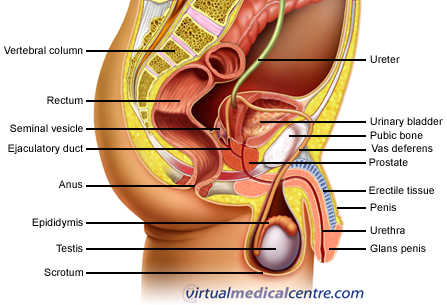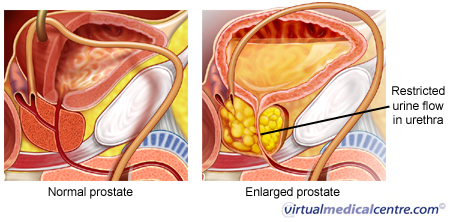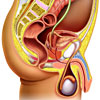- What is Enlarged Prostate (Benign Prostatic Hyperplasia)?
- Statistics
- Risk Factors
- Progression
- Symptoms
- Clinical Examination
- How is it Diagnosed
- Prognosis
- Treatment
- References
What is Enlarged Prostate (Benign Prostatic Hyperplasia)?
Benign prostatic hyperplasia (BPH) is a condition in which benign (non-cancerous) nodules cause an enlargement of the prostate gland. A healthy prostate gland is responsible for producing semen. As a general rule, hyperplasia tends to occur in central glands of the prostate, close to the urethra. The urethra is the tube that transports urine and semen through the penis.

Statistics
Benign prostatic hyperplasia is a progressive enlargement of the prostate gland which usually starts in middle age. Nearly all Australian men will develop an enlarged prostate gland if they live long enough.
Prostate examination in a series of unselected autopsies found that 20% of men at the age of 40 years had an enlarged prostate, 70% at age 60, and 90% by the age of 80 years old. With an incidence so great, it has been suggested that prostate enlargement is a normal process of ageing and does not reflect a disease process. However, approximately 25% of men will require surgery to treat the symptoms of an enlarged prostate.
Risk Factors
As the enlarged prostate is very common, there are no identifiable predisposing factors for this condition. Testosterone is linked to the development of an enlarged prostate gland. The condition is not seen in castrated males.
Progression
Prostate enlargment is a slowly progressive condition that usually occurs over the age of 50 years, and increases in prevalence with age. The condition does not predispose the man or his immediate family to any increased risk of prostate cancer.
With progression of the disease, the patient will develop increasing urinary symptoms such as difficulty in passing urine as the enlarged prostate creates a urinary outflow obstruction.
If left without intervention, the patient may develop complete urinary obstruction that must be relieved to prevent renal failure. Poor access to medical services in this setting may pose a significant threat to the patient. With adequate access to medical services, however, obstruction may be easily managed with urinary catheterisation.

How is it Diagnosed
Prostate specific antigen (PSA)
Prostate specific antigen (PSA) is produced by the prostate gland. The amount produced increases in both malignant and benign conditions of the prostate gland. The greater the amount of PSA in the blood, the greater the likelihood of prostate cancer.
As a single measurement, PSA is an unreliable marker of prostate disease, but when measured over time, the PSA velocity allows better differentiation of malignant and benign conditions.
Transrectal ultrasonography (TRUS)
There are no clear-cut ultrasound features that distinguish benign prostatic hypertrophy from prostate cancer. This investigation, however, allows further assessment of cancer risk.
Prognosis
The outlook for benign prostatic hyperplasia is good; although it can cause significant discomfort, the condition is benign. As the prostate gland grows in size, symptoms may become worse, warranting medication or surgery. With appropriate medical and/or surgical management, the symptoms of an enlarged prostate gland can be treated effectively.
Treatment

Treatments for benign prostatic hyperplasia include medical and surgical options.
Medical treatment
Medical treatment is usually reserved for men who have significant symptoms. The available drugs include:
- Terazosin belongs to a class of medications which relax the smooth muscles of the arteries, the prostate, and the bladder neck. This helps relieve urinary obstruction caused by an enlarged prostate in BPH. Side effects can include headaches. Also, these medicines sometimes make people feel dizzy, lightheaded, or tired. Alpha blockers are new drugs, so doctors do not know their long-term effects.
- Finasteride is a drug that inhibits the action of the male hormone testosterone and helps to shrink the prostate. Side effects of finasteride include declining interest in sex, problems getting an erection, and problems with ejaculation. Because it is a new drug, doctors are not sure about its long-term effects.
Surgery
Surgery is the treatment most likely to relieve BPH symptoms. However, it also has the most complications. Doctors use two kinds of surgery for BPH:
- Transurethral resection of the prostate (TURP) is the most common. The patient is put to sleep under general anaesthetic and the prostate gland is ‘shelled out’ from inside the bladder. This should relieve the obstructive symptoms in BPH. However, TURPs can only be used if the prostate is not too enlarged.
- Open surgery is used when the prostate is very enlarged. In open surgery, the surgeon makes an incision in the abdomen or between the scrotum and the anus to remove prostate tissue. (a radical prostatectomy).
More information
 |
For information on prostate cancer, including diagnoses, types of treatments, and some useful tools, videos and animations, see Prostate Cancer. |
References
- Australian Government Department of Health and Ageing. Bladder Problems and the Prostate. 2003.
- Braunwald, Fauci, Kasper, Hauser, Longo, Jameson. Harrison’s Principles of Internal Medicine (15th edition). McGraw-Hill; 2001.
- Burkitt G. Essential Surgery: Problems, diagnosis and Management. 3rd ed.
- Cotran, Kumar, Collins 6th edition. Robbins Pathologic Basis of Disease. WB Saunders Company. 1999.
- Kumar P, Clark M. Clinical Medicine. WB Saunders 2002 Pg 545-549.
- Longmore M, Wilkinson I, Torok E. Oxford Hnadbook of Clinical Medicine. Oxford University Press. 2001
- Tjandra J., Clunie G., Thomas R. Textbook of Surgery 2nd Edition. Blackwell Publishing 2001.
All content and media on the HealthEngine Blog is created and published online for informational purposes only. It is not intended to be a substitute for professional medical advice and should not be relied on as health or personal advice. Always seek the guidance of your doctor or other qualified health professional with any questions you may have regarding your health or a medical condition. Never disregard the advice of a medical professional, or delay in seeking it because of something you have read on this Website. If you think you may have a medical emergency, call your doctor, go to the nearest hospital emergency department, or call the emergency services immediately.







